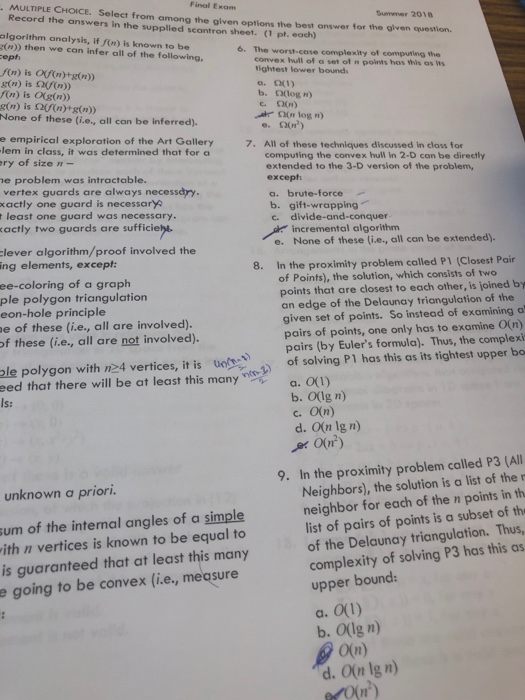Please provide the correct answers since Im not sure about these answers:

Final Exom MULTIPLE CHOICE. Solect from among the given options the best answer for the given ouestion. Summer 2018 Record the answers in the supplied scontron sheet. (1 pt. each) algorithm analysis, if F(n) is known to be (n)) then we can infer all of the following. 6. The worst-case complexity of computing the /(n) is Of(n)+x(n)) g(n) is (n)) /(n) is gin)) g(n) is Qf(n)+g(n) None of these (i.e., all can be inferred). convex hull of a set of n points hos iis as ns ightest lower bound o. 01) b. O(log n) e, ?(n) ?(n log n) t epoioof the lery7. All of these techniques discussed in class for lem in class, it was determined that for a ry of size n - e problem was intractable. vertex guards are always necessdry. xactly one guard is necessary least one guard was necessary. actly two guards are sufficie computing the convex hull in 2-D con be directly extended to the 3-D version of the problem, except a. brute-force b. gift-wrapping c. divide-and-conquer incremental algorithm e. None of these (i.e., all can be extended). lever algorithm/proof involved the ing elements, except: In the proximity problem called P1 (Closest Pair of Points), the solution, which consists of two points that are closest to each other, is joined by an edge of the Delaunay triangulation of the given set of points. So instead of examining a pairs of points, one only has to examine O(n) pairs (by Euler's formula). Thus, the complexi 8. ee-coloring of a graph ple polygon triangulation eon-hole principle e of these (i.e., all are involved). of these (i.e., all are not involved). of solving P1 has this as its tightest upper bo ple polygon with n24 vertices, it is o eed that there will be at least this many a. OU Is: b. O(lg n) C. d. O(n lg n) Neighbors), the solution is a list of the neighbor for each of the n points in th list of pairs of points is a subset of th of the Delaunay triangulation. Thus, complexity of solving P3 has this as upper bound: 9. In the proximity problem called P3 (All unknown a priori. of the internal angles of a simple ith n vertices is known to be equal to is guaranteed that at least this many going to be convex (ie, mecsure sum b. O(lg n) O(n) d. O(n lg n) nr)








